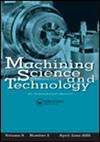Finite element simulation and experimental investigation of machining induced residual stresses in ultrasonic elliptical vibration-assisted turning
IF 2.6
4区 工程技术
Q2 ENGINEERING, MANUFACTURING
引用次数: 2
Abstract
Abstract In this study, an experimental study and three-dimensional finite element simulation of ultrasonic elliptical vibration-assisted turning (UEAT) are investigated. In addition, the comparison of this process with ultrasonic-assisted turning (UAT) and conventional turning (CT) is also provided. First, a three-dimensional FEM has been developed to study the cutting forces, friction coefficient, and residual stresses in CT, UAT, and UEAT. For the experimental tests, a special design of elliptical vibration tool with two bending modes (along feed and cutting speed) is proposed and fabricated. Then, the effect of vibration amplitude, cutting speed, and feed on the machining residual stresses during hard turning of AISI4340 steel has been explored. Finally, the developed FEM is validated with the experimental test results. According to the obtained results, by applying elliptical vibrations on the cutting tool in UEAT, machining residual stresses became more compressive on averagely by 49%. Moreover, the application of elliptical ultrasonic vibrations with amplitudes of 6 and 12 μm had made machining residual stresses 34 and 64% more compressive, respectively.超声椭圆振动辅助车削加工残余应力的有限元模拟与实验研究
摘要本文对超声椭圆振动辅助车削(UEAT)进行了实验研究和三维有限元仿真。此外,还将该工艺与超声辅助车削(UAT)和传统车削(CT)进行了比较。首先,开发了一个三维有限元来研究CT、UAT和UEAT中的切削力、摩擦系数和残余应力。在实验测试中,提出并制作了一种具有两种弯曲模式(沿进给和切削速度)的椭圆振动刀具的特殊设计。然后,探讨了AISI4340钢在硬车削过程中振动幅度、切削速度和进给量对加工残余应力的影响。最后,用实验测试结果对所建立的有限元模型进行了验证。结果表明,在UEAT中,通过对刀具施加椭圆振动,加工残余应力平均压缩49%。此外,振幅为6和12的椭圆超声振动的应用 μm使加工残余应力分别增加34%和64%。
本文章由计算机程序翻译,如有差异,请以英文原文为准。
求助全文
约1分钟内获得全文
求助全文
来源期刊

Machining Science and Technology
工程技术-材料科学:综合
CiteScore
5.70
自引率
3.70%
发文量
18
审稿时长
6 months
期刊介绍:
Machining Science and Technology publishes original scientific and technical papers and review articles on topics related to traditional and nontraditional machining processes performed on all materials—metals and advanced alloys, polymers, ceramics, composites, and biomaterials.
Topics covered include:
-machining performance of all materials, including lightweight materials-
coated and special cutting tools: design and machining performance evaluation-
predictive models for machining performance and optimization, including machining dynamics-
measurement and analysis of machined surfaces-
sustainable machining: dry, near-dry, or Minimum Quantity Lubrication (MQL) and cryogenic machining processes
precision and micro/nano machining-
design and implementation of in-process sensors for monitoring and control of machining performance-
surface integrity in machining processes, including detection and characterization of machining damage-
new and advanced abrasive machining processes: design and performance analysis-
cutting fluids and special coolants/lubricants-
nontraditional and hybrid machining processes, including EDM, ECM, laser and plasma-assisted machining, waterjet and abrasive waterjet machining
 求助内容:
求助内容: 应助结果提醒方式:
应助结果提醒方式:


